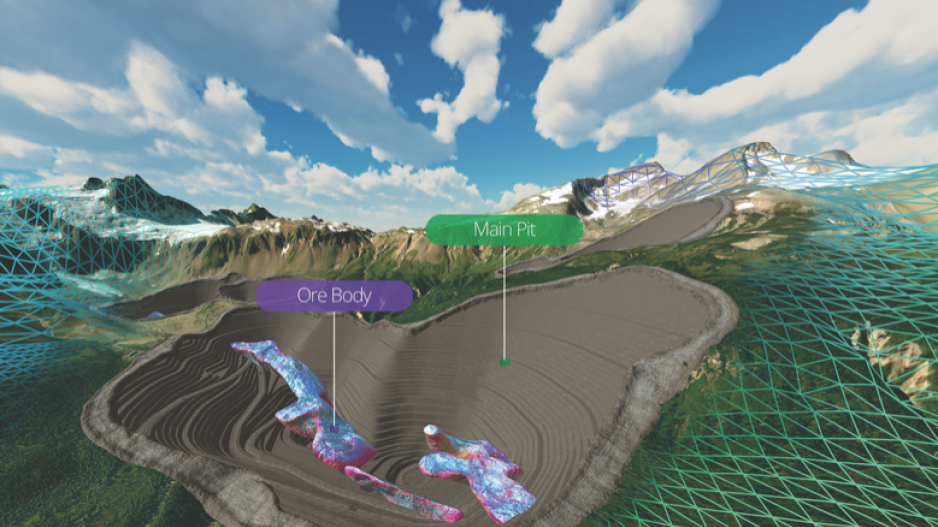Charles Lavigne zooms across 30,000 square kilometres of rugged British Columbia terrain. In seconds, he calls up 50 years and 300,000 metres of drill hole data with a couple of flicks of his wrist.
It took Victoria-based Llamazoo Interactive Inc. about a month to take nearly a terabyte of data from Teck Resources Ltd. (TSX:TECK.B) and visualize it in 3D form.
“Within a month we had a 50-year visualization of a mine plan for a mine that doesn’t even exist,” said Lavigne, CEO and co-founder of Llamazoo, which has offices in Vancouver.
“That kind of blew some people’s minds.”
According to the company, Teck Resources’ Galore Creek project in northwestern B.C. sits on one of the world’s largest undeveloped copper and gold deposits. In 2018, a variety of field programs will be conducted at the site, but on Llamazoo’s MineLife VR platform, the work is done.
At a one-to-one ratio, users wearing a virtual reality (VR) headset get an accurate depiction of the area’s geography, its rivers, trees and environmental challenges. They can navigate future site facilities and infrastructure and dive into the proposed mine itself. They can even see things they otherwise wouldn’t, such as the ore body in the ground.
“You don’t need to have any particular skill sets to understand what you’re looking at. It’s essentially like you’re right there,” said Greg Brouwer, general manager of technology and innovation at Teck. “It’s actually in many ways more effective than taking people into an area physically because you can so easily and quickly see such a large area.”
Last week, Lavigne pitched Llamazoo’s value proposition to about 1,200 industry representatives as one of four international finalists in Goldcorp Inc.’s (TSX:G) #DisruptMining competition (see story on page 18), held last week at the Prospectors & Developers Association of Canada’s annual convention in Toronto.
While his company didn’t take home the top prize – a $1 million contract with the Vancouver-based mining giant – selection as a finalist is a high honour, especially considering Llamazoo has been targeting the mining space for just under a year.
The company’s story dates back to 2014, when Lavigne and co-founder Kevin Oke started out with the idea for the technology – a platform for 3D content – but without a problem to solve.
“We kind of knew that it was coming, and it’s going to be big, and it’s going to keep getting bigger,” said Lavigne.
Their first success came in education with a product called EasyAnatomy, the world’s first medically accurate 3D canine cadaver. Developed in collaboration with five universities, the product was designed to provide veterinary students with a more flexible learning alternative to physical dissection.
“We didn’t know anything about veterinary medicine. We kind of went in and disrupted how they taught anatomy there. So if there’s one kind of pattern about Llamazoo, it’s that we kind of see spaces that are ripe for disruption and go in and turn things on their head.”
After the product launched a year and a half ago – it’s now in 120 veterinary schools worldwide – Lavigne said his team did their own post-mortem on the project. They looked at what they had done – built a way to process and visualize big data – and where else they could apply it.
“The resource sector has tons of data and they don’t know what to do with it,” said Lavigne.
“I truly believe that AR [augmented reality], VR and spatial data visualization is going to be one of these paradigm-shifting technologies, because it’s going to allow people to communicate around their data much quicker, faster, and collaborate around it.”
Teck was the first mining company to jump on board with Llamazoo, and Lavigne said his company is in conversations with 15 of the world’s top 20 producers. (His presentation at the Prospectors & Developers convention has also spurred significant interest.)
Given Galore Creek’s remote location, Brouwer said MineLife VR has been arguably more effective than in-person visits for certain types of interactions. It has saved the company from physically taking stakeholders to the site, which is surrounded by glaciers and often covered in metres of snow. The product’s visual nature and information overlays help the company clearly communicate its plans to community stakeholders, and Brouwer said the tool has enhanced the company’s productivity and mine and reclamation planning.
Depending on use case, number of users and project size, Llamazoo can build a virtual mine site for $150,000 to $300,000, plus an additional software-as-a-service annual fee.
According to Lavigne, the company’s services unlock data that may be siloed in certain departments; it makes it accessible to those who wouldn’t have the technical expertise to read geological surveys or engineering reports.
“To date, they’ve just been using PowerPoint or aerial photos, which doesn’t really convey the scale or necessarily the environmental challenges about a specific area. And now they can actually fly there virtually,” he said.
While the company is just getting started in the mining space, Lavigne said they’re already dipping their toes into the oil and gas and forestry industries. They’re developing their digital twinning technology – which re-creates every nut and bolt of a physical asset in digital form, allowing someone to see the real-world operation conditions remotely.
Down the road, Llamazoo will also look to offer services that would be financially accessible to smaller mining players – a sort of plug-and-play service that would allow companies to input their own data and customize it to their needs.
“I think there is a realization that disruption and innovation is critical for the survival of the industry,” said Lavigne.
“It’s accelerating at such a fast pace, and the applications need to be unearthed by working with people in the industry.”




